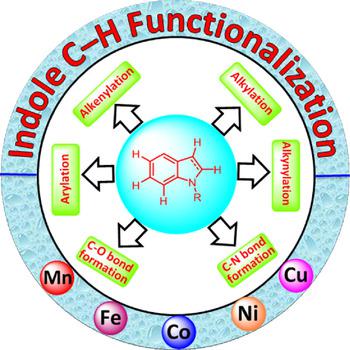当前位置:
X-MOL 学术
›
Asian J. Org. Chem.
›
论文详情
Our official English website, www.x-mol.net, welcomes your feedback! (Note: you will need to create a separate account there.)
C−H Functionalization of Indoles by 3d Transition‐Metal Catalysis
Asian Journal of Organic Chemistry ( IF 2.7 ) Pub Date : 2019-12-10 , DOI: 10.1002/ajoc.201900554 Rahul A. Jagtap 1 , Benudhar Punji 1
Asian Journal of Organic Chemistry ( IF 2.7 ) Pub Date : 2019-12-10 , DOI: 10.1002/ajoc.201900554 Rahul A. Jagtap 1 , Benudhar Punji 1
Affiliation

|
Over the past decade, the use of 3d transition metal for the regioselective C−H bond functionalization of indoles has significantly increased. Particularly, advances in manganese, iron, cobalt, nickel and copper catalysis have demonstrated the selective C(2)−H and C(3)−H arylation, alkenylation, alkynylation and alkylation to a greater extent. Similarly, the C−O and C−N bond‐forming reactions are manifested via direct C−H bond activation by these earth‐abundant metals. The emergence of 3d metals in selective functionalization of the biologically relevant indoles and related heteroarenes would make this protocol more attractive for practical applications. Herein, we provide a brief overview of 3d transition metal‐catalyzed (mostly Mn, Fe, Co, Ni and Cu) C−H functionalization of indoles and related heteroarenes.
中文翻译:

通过3d过渡金属催化实现吲哚的CH功能化
在过去的十年中,将3d过渡金属用于吲哚的区域选择性CH键的功能化已大大增加。特别是,锰,铁,钴,镍和铜催化的进展已显示出更大程度的选择性C(2)-H和C(3)-H芳基化,烯基化,炔基化和烷基化。类似地,这些富含地球的金属通过直接的C-H键活化作用而显示出C-O和C-N键形成反应。3d金属在生物学上相关的吲哚和相关杂芳烃的选择性功能化中的出现将使该协议对实际应用更具吸引力。本文中,我们简要概述了3d过渡金属催化的吲哚和相关杂芳烃的MH官能化(主要是Mn,Fe,Co,Ni和Cu)。
更新日期:2019-12-11
中文翻译:

通过3d过渡金属催化实现吲哚的CH功能化
在过去的十年中,将3d过渡金属用于吲哚的区域选择性CH键的功能化已大大增加。特别是,锰,铁,钴,镍和铜催化的进展已显示出更大程度的选择性C(2)-H和C(3)-H芳基化,烯基化,炔基化和烷基化。类似地,这些富含地球的金属通过直接的C-H键活化作用而显示出C-O和C-N键形成反应。3d金属在生物学上相关的吲哚和相关杂芳烃的选择性功能化中的出现将使该协议对实际应用更具吸引力。本文中,我们简要概述了3d过渡金属催化的吲哚和相关杂芳烃的MH官能化(主要是Mn,Fe,Co,Ni和Cu)。



























 京公网安备 11010802027423号
京公网安备 11010802027423号